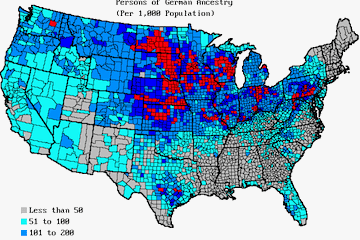German Immigration, the "Forty-Eighters", and their Cultural Legacy
One of the great waves of immigration to the United States occurred in the mid-19th century from Germany. Many left because of economic conditions and the promise of opportunity in the United States. A smaller group consisted of political refugees from a series of failed revolutions in 1848. This group, the "Forty-Eighters", had many writers, reformers, and politicians. As a whole, Germans moved to many newly-settled areas of the country and provided their own cultural influences to the American tradition. Cincinnati, Milwaukee, and St. Louis were three cities with large German populations.
The influences of the German migration were many. To take one example, whiskey and hard liquor were the most common alcoholic drinks in the early 19th century. Germans, however, brought a love of beer with them that left a long legacy. Heavily German towns such as Milwaukee and St. Louis became centers of the brewing trade and left the United States with many of its most famous brands (Anheuser-Busch, Pabst, Schlitz). A cultural affinity for festivals and recreation led to more public celebrations and an advocacy for parks and other public facilities. They also brought the Christmas tree and Santa Claus into America's celebration of the holidays.
The Forty-Eighters arrived in the wake of a failed revolution in Germany. This was a much more educated and prosperous group of immigrants. Many arrived in the new state of Texas and helped to populate it. Others settled in the Midwest and became active in politics or publishing. One of the most famous of these immigrants was Carl Schurz. Arriving in 1852, Schurz became a farmer in Wisconsin and later a lawyer and organizer for the nascent Republican Party. Schurz was a Union general in the Civil War (even in Texas, most Germans opposed secession) and served as a Senator from Missouri and as Secretary of the Interior during the 1870s. Margarethe Schurz, his wife, established the United States's first kindergarten.
The 1850s witnessed the rise and fall of the nativist Know-Nothing Party. This group focused its energy towards denouncing the new immigrants to the United States. In this era, the two main groups of newcomers hailed from Germany and Ireland. The influence of these groups was often seen as detrimental to American culture. The huge expansion of cost in public relief programs in many cities also drove resentment. This party won 51 seats in the House in 1854 and ran a strong campaign for President in 1856. It particularly focused on the dangers of Catholicism. Since some Germans were Catholic and others not, this focus did not affect all of them equally.
Germans would remain conspicuous for a long time. Though largely accepted into American society, there was a fierce backlash against them during World War I. German newspapers, schools, and churches came under immense suspicion and were often forced to close or use English. Streets and buildings were renamed to sound less German. German foodstuffs were temporarily renamed, such as the changing of sauerkraut to "liberty cabbage". While there are numerous Americans of German descent in modern times, very few speak German fluently or have a strong attachment to their old homeland.
